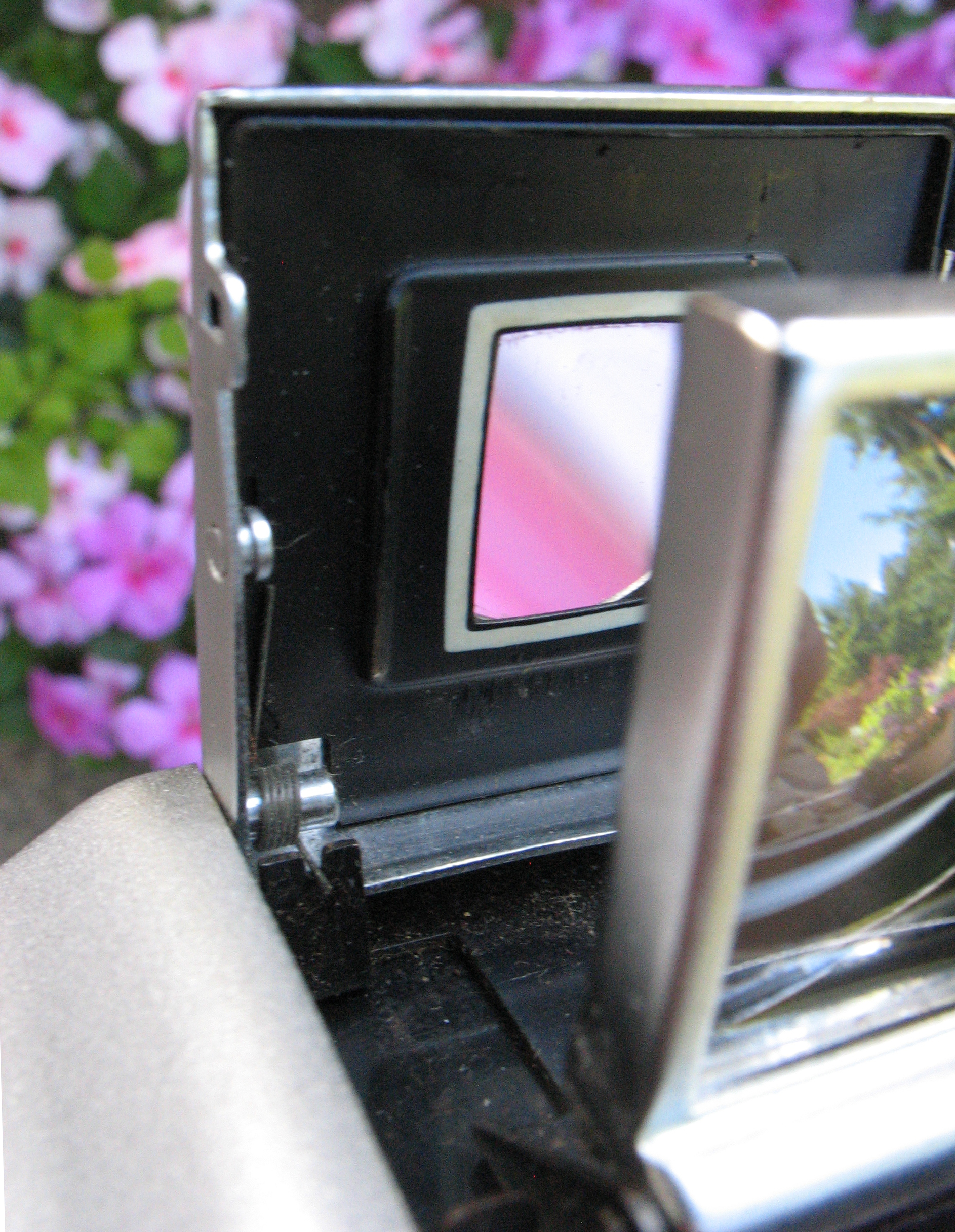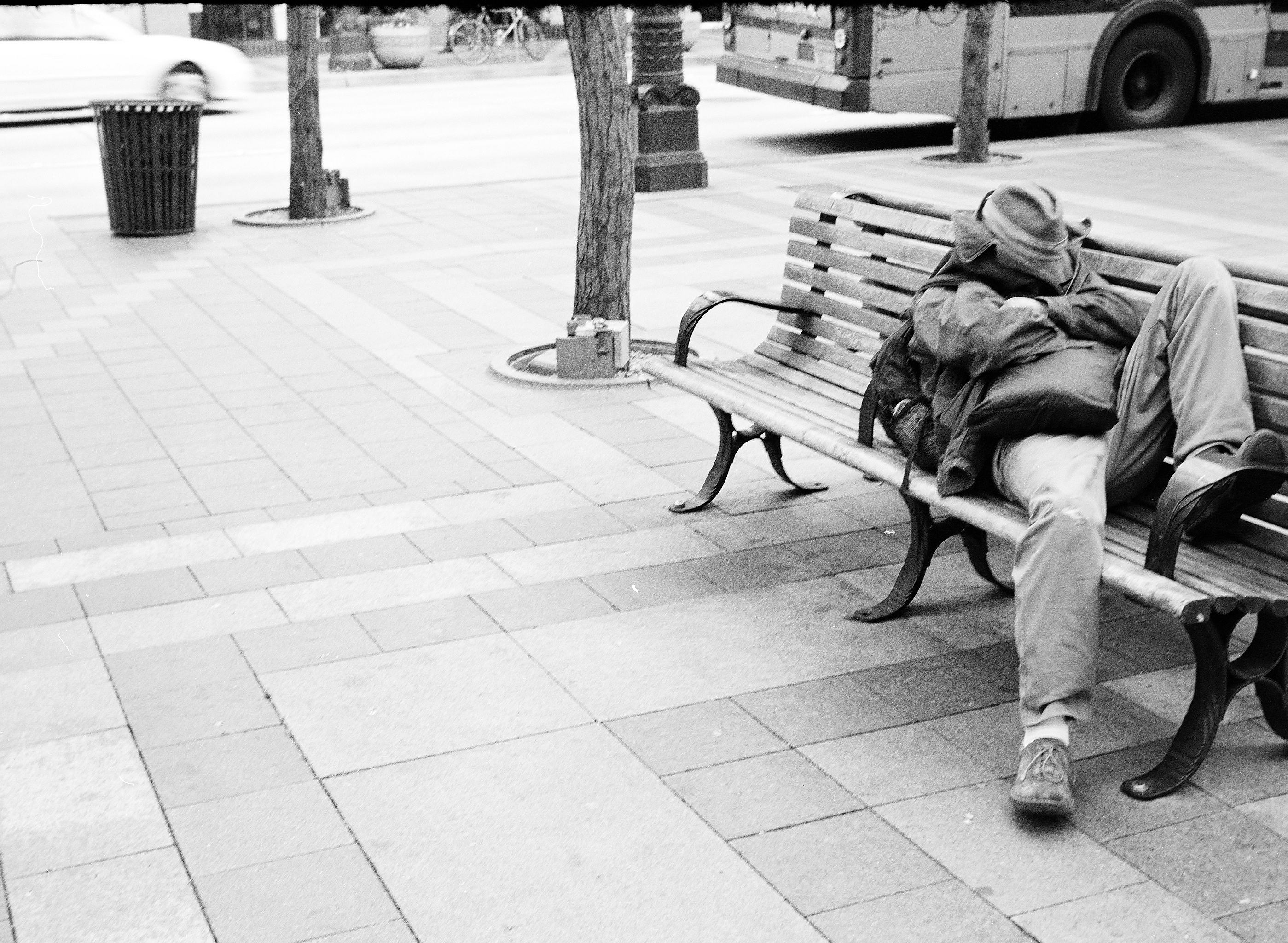There are times when I’m creative because I’m creative, and there are times when I’m creative because I’m scrambling to fix an error or rescue an image. This photograph is one of the latter cases, and I ended up being ripped away from my comfortable dependence on the Rule of Thirds.
The 1950 Ensign Selfix 16-20 is my primary street photography camera. It is a superb little camera, hardly larger than a point-and-shoot, yet with the excellent Ross Xpres lens and a full range of shutter speeds.
I recently spent two wonderful afternoons wandering the streets of Seattle, and shot two rolls of film of street people and an itinerant street preacher with the Ensign. Receiving my film scans two weeks later, I was dismayed to find misaligned images with space above the heads and feet cut off! After many years of photography, I should be able to avoid cutting off feet!
A careful examination of the Ensign’s pop-up Albada viewfinder revealed it to be more sophisticated than I had realized. Peering through the rear window, one sees the image, together with a superimposed pale inner frame which I had ignored, taking it to be a reflection of the eyepiece. However, on examining the finder more carefully, it is clear that a white mask painted on the inner surface of the eyepiece is designed to reflect on the front finder
lens, forming the true frame for the image. Research on Albada viewfinders indicates that this is how they work – information that I should have known from the start (see References). These are the challenges in working with older cameras that make it rewarding – and frustrating!
Now that I had discovered how to use the finder, I was faced with the problem of two rolls of dramatic but misaligned images. Some were past saving, but I began cropping in an effort to use the remaining images. The sleeping street person was a problem; his
foot hit the edge of the frame, and he definitely could not be aligned according to the Rule of Thirds. I decided to see if I could use the misalignment for dramatic effect. I cropped from the top, removing the bus and as much of the upper extraneous detail as possible, while leaving in place as much of the empty space in the square as possible. I then cropped from the left, removing the base of the trash bin, and leaving the unkempt sleeping figure surrounded by the empty space, the bases of trees and a solitary lamp post. In this arrangement, the surrounding empty square emphasizes the isolation of the sleeping figure, and may be more effective than a traditionally-balanced image.
References:
Oleson, R.A. “Looking Forward: The Development of the Eye Level Viewfinder.” http://rick_oleson.tripod.com/looking_forward.htm.
Petrakla, P. “Petrakla Classic Camera Site: Albada Viewfinders.” http://www.petrakla.com/TricksTechniques/Albadaviewfinders/Albadaviewfinders.html.
Rangefinderforum.com. “How to Get the Best Results From an Albada Viewfinder.” http://www.rangefinderforum.com/forums/archive/index.php/t-70726.html.



Hi Dr. Rand,
I find your creative cropping, of July 3rd, 2010, very powerful and interesting and it is exactly what I usually do for all the technical reasons given. But, for me, the subject is a difficult thing and I usually avoid that degree of intimacy in my own limited photography.
I suppose one wonders just how close you can get in capturing such subjects. As a youth, I spent several years in Paris in the 50s. I had an M3 and I wanted to capture how the street people lived. To achieve this I rented a bench near the Seine, limited myself to a few Francs a day and sat there trying to absorb it all and find a way to melt into and yet capture it. Around Notre Dame, I found that most people I met were either tourists from the Eastern Bloc, Gendarmes, or people who lived by being street performers. The former found a great satisfaction and confirmation of their political beliefs to see a down and out American in torn jeans and ragged shirt. The police were very nice, rarely enforced the law and loved Lucky Strikes. The latter were very sharing and sometimes I monitored the tip hat or box during their performances. Afterwards, I was invited to do the wine, bread and cheese thing. Of course, I shared my Lucky Strikes. Today, I have a lot of photos of book stalls, couples strolling and day and night Seine photos, but none of the street people I met there. I guess I became too close to presume I could tell a story with photography. So, congratulations on the photo, I really enjoyed the technical aspects and the subject also evoked a sense of another time for me… So, what more could a photo do? Thanks.
Les – Columbia SC
Thank you for your thoughtful comment! I really appreciate your taking so much time to share your thoughts. Glad you enjoyed the picture. I have three more that I will post later.
I agree that deciding which pictures to take is a challenge. I am constantly aware of this when I am on the street. I think that some individuals are fair game, like the street preacher who rails against evolution. Others require more thought. I usually ask anyone who is going to be recognizable if they mind my taking their picture. Some street people and performers don’t mind.
I do think, however, that there is a predatory element to all artists. We interact with those close to us, and bits and pieces of them show up in our novels and paintings. We photograph those around us, and they end up in books and shows. Yet we must always respect people’s dignity and privacy. It is a difficult balance, and not always a comfortable one. I may do a post on this.
Thanks for your thoughts. Keep reading, and I will keep trying to make the blog interesting.
Hi Dr. Collins, definitely not being critical, I just have a few hang-ups, most of which comes from being raised on a small ranch in Oklahoma and then later a mining community in Appalachia. So, I tend to roughly identify with groups impacted by poverty. But, identifying is certainly not related to personally being accepted by such groups. I would definitely not fit.
I have taken such photographs in the remote areas of Viet Nam, Korea, Thailand, Oman, Egypt and Saudi Arabia (Not so much poverty there). Some of the conditions in these countries, especially for children, would melt even a stone. The poverty here in the Southern US is also very bad. But, I would never take a photo of such poverty, simply because the adults would beat you up for doing so and what would such a photo prove anyway?
So, there are definitely a lot of situations that we both recognize as being both OK and off limits. Unfortunately, there are no written rules for anything, but there is common sense!
Speaking of common sense, while going to a military school in San Antonio, Texas, a friend from rural Iowa and I were visiting a Mexican border town and he was appalled by the poverty he observed. He was particularly drawn to several small children playing in a filthy court yard. So, he whipped out his trusty Argus C 44 and started to take photos, which he wanted to share with his church class back in Iowa. I strongly suggested that we needed to leave immediately. Well, it was too late, as three angry Mexican males, supposedly with the local police force stopped us. They demanded his camera and proceeded to rip out the film and expose it… they then threw the film into the gutter and told us to leave Mexico. He was incensed to say the least. He indicated to them, that he was an American citizen and his private property couldn’t be treated that way… I retrieved his camera and drug him off toward the border crossing. The three guys followed us all the way to the bridge crossing. There he pointed them out while reporting them to the US Border Guards. I could only be amazed.
Your comment, …we must always respect people’s dignity and privacy. It is a difficult balance, and not always a comfortable one… sums it up very well. I think a post on the subject would be very good. Interesting what the IDCC would do with it.
P.S. I am still looking for a good 120 Kodak No. 1 folder. I just bought one on Ebay, which looked pretty good. This is the third one I have purchased and maybe it is the one. The price is definitely going up!
Les Hall
Columbia, SC